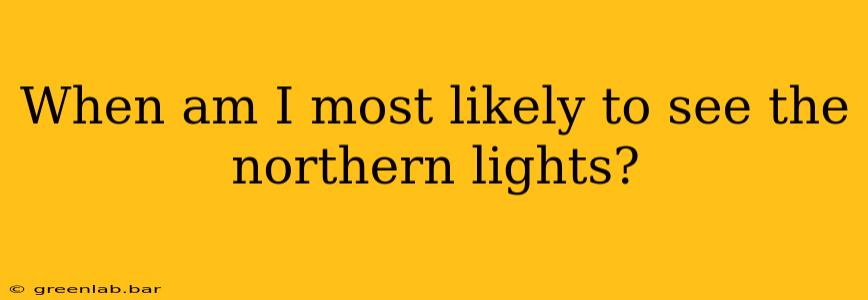The ethereal dance of the aurora borealis, the Northern Lights, is a spectacle that captivates the hearts of many. But witnessing this celestial wonder requires more than just a wish; it involves understanding the optimal conditions and timing for viewing. This comprehensive guide will equip you with the knowledge to maximize your chances of seeing this breathtaking natural phenomenon.
Understanding the Science Behind the Northern Lights
Before diving into the best viewing times, let's briefly understand what causes the aurora. Charged particles from the sun, carried on the solar wind, collide with gases in the Earth's atmosphere. This interaction excites the gases, causing them to emit light – the mesmerizing display we know as the aurora borealis. The intensity and frequency of these auroras are directly related to solar activity.
The Key Factors Influencing Aurora Visibility
Several crucial factors determine your likelihood of seeing the Northern Lights:
1. Time of Year:
- Winter Months (September - April): This is the prime viewing season. Longer nights provide extended viewing opportunities. The darkness is crucial; you won't see the aurora during daylight hours.
2. Geomagnetic Activity:
- Solar Flares and Coronal Mass Ejections (CMEs): These solar events are the primary drivers of auroral activity. Stronger solar activity leads to more vibrant and widespread auroras. You can monitor space weather forecasts (discussed below) to check for these events.
3. Location:
- High Latitudes: The aurora is most visible at high latitudes, within the auroral oval – a ring-shaped zone encircling the Earth's magnetic poles. Popular viewing locations include Alaska, Canada, Iceland, Norway, Sweden, Finland, Greenland, and Russia.
4. Light Pollution:
- Dark Skies are Essential: Light pollution from cities significantly reduces visibility. Seek out locations far from urban areas with minimal artificial light. Dark sky parks and reserves are ideal choices.
5. Weather Conditions:
- Clear Skies are Key: Cloud cover will completely obscure the aurora. Check weather forecasts meticulously before heading out for viewing.
Optimizing Your Chances of Seeing the Northern Lights
Here's a practical approach to maximize your chances of witnessing this incredible phenomenon:
1. Monitor Space Weather Forecasts:
Websites and apps provide real-time updates on geomagnetic activity. Look for KP-index values; higher numbers indicate stronger auroral activity. A KP-index of 5 or higher often suggests visible auroras even at lower latitudes.
2. Plan Your Trip During Peak Aurora Season:
The winter months (September to April) offer the longest nights and the best chances of clear skies. However, even within this period, certain months might be statistically more favorable based on historical data for specific locations.
3. Choose a Location Strategically:
Select a location known for its dark skies and high latitude, away from city lights. Consider locations with established aurora viewing tours and accommodations designed for aurora viewing.
4. Check Weather Forecasts:
Monitor weather forecasts closely. Clear skies are absolutely essential for aurora viewing. Even a slight cloud cover can hinder your chances.
5. Be Patient and Persistent:
Aurora viewing requires patience. They are not always visible every night, even during peak season. Spend several nights in your chosen location to increase your chances of success.
Conclusion: Your Northern Lights Adventure Awaits
Seeing the Northern Lights is a truly unforgettable experience. By understanding the science behind the aurora, monitoring space weather, and planning your trip meticulously, you can significantly increase your chances of witnessing this breathtaking display of nature's artistry. Remember, patience and preparation are your allies in this incredible celestial pursuit. So pack your bags, embrace the adventure, and prepare to be mesmerized by the magical dance of the aurora borealis!

